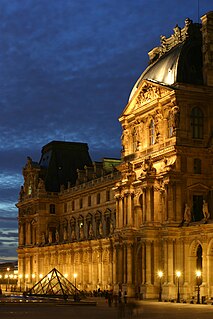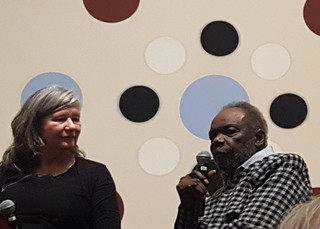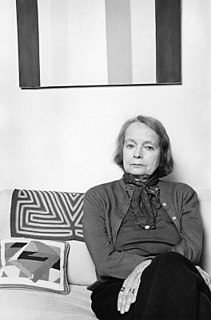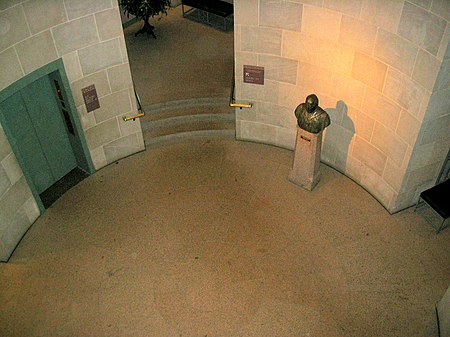
An art museum or art gallery is a building or space for the display of art, usually from the museum's own collection. It might be in public or private ownership and may be accessible to all or have restrictions in place. Although primarily concerned with visual art, art museums are often used as a venue for other cultural exchanges and artistic activities, such as lectures, performance arts, music concerts, or poetry readings. Art museums also frequently host themed temporary exhibitions, which often include items on loan from other collections.

The Arthur M. Sackler Gallery is an art museum of the Smithsonian Institution in Washington, D.C., focusing on Asian art. The Sackler Gallery and the Freer Gallery of Art together form the Smithsonian's national museums of Asian art in the United States. The Freer and Sackler galleries house the largest Asian art research library in the country.

Museology or museum studies is the study of museums. It explores the history of museums and their role in society, as well as the activities they engage in, including curating, preservation, public programming, and education.

The Smithsonian American Art Museum is a museum in Washington, D.C., part of the Smithsonian Institution. Together with its branch museum, the Renwick Gallery, SAAM holds one of the world's largest and most inclusive collections of art, from the colonial period to the present, made in the United States. The museum has more than 7,000 artists represented in the collection. Most exhibitions take place in the museum's main building, the old Patent Office Building, while craft-focused exhibitions are shown in the Renwick Gallery.
Yuriko Yamaguchi is a Japanese American sculptor and print artist. Using more natural mediums, she creates abstract designs that are used to reflect deeper symbolistic ideas. She currently resides near Washington, DC, and is represented by Barbara Davis Gallery in Houston, Texas.

Sam Gilliam is an African-American color field painter and lyrical abstractionist artist. Gilliam is associated with the Washington Color School, a group of Washington, D.C. area artists that developed a form of abstract art from color field painting in the 1950s and 1960s. His works have also been described as belonging to abstract expressionism and lyrical abstraction. He works on stretched, draped and wrapped canvas, and adds sculptural 3D elements. He is recognized as the first artist to introduce the idea of a draped, painted canvas hanging without stretcher bars around 1965. This was a major contribution to the Color Field School.

Betty Parsons was an American artist, art dealer, and collector known for her early promotion of Abstract Expressionism. She is regarded as one of the most influential and dynamic figures of the American avant-garde.

Otto Piene was a German-American artist specializing in kinetic and technology-based art, often working collaboratively. He lived and worked in Düsseldorf, Germany; Cambridge, Massachusetts; and Groton, Massachusetts.
Salomón Huerta is a painter based in Los Angeles, California who comes from Tijuana, Mexico and grew up in the Boyle Heights Projects in East Los Angeles. Huerta received a full scholarship to attend the Art Center College of Design in Pasadena, and completed his MFA at UCLA in 1998. Huerta gained critical acclaim and commercial attention in the late 1990s for his minimalist portraits of the backs of people's heads and color saturated depictions of domestic urban architecture. He was included in the 2000 Whitney Biennial and has been featured in numerous exhibitions around the US, Europe, and Latin America such as The Gagosian Gallery in London, England and Studio La Città in Verona, Italy. Salomón Huerta is currently represented by Louise Alexander Gallery/There There in Los Angeles, California and Porto Cervo, Italy.

The Huntington Museum of Art is a nationally accredited art museum located in the Park Hills neighborhood above Ritter Park in Huntington, West Virginia. Housed on over 50 acres of land and occupying almost 60,000 square feet, it is the largest art museum in the state of West Virginia. The museum's campus is home to nature trails and the C. Fred Edwards Conservatory, a subtropical and tropical plant conservatory. The museum's collection includes American and European paintings, sculptures, prints, and drawings, as well as glass pieces manufactured in West Virginia and the Ohio Valley, American folk art, Chinese and Japanese decorative objects, Haitian art, firearms, and decorative arts from the Near East. In addition to its permanent collections, the museum hosts traveling exhibitions and houses the James D. Francis Art Research Library, the Grace Rardin Doherty Auditorium, and five art studios where artists in residence are periodically hosted and classes are held. The Huntington Museum of Art holds one of the largest collections of art in the state of West Virginia.
Mario Martinez is a Native American contemporary abstract painter. He is a member of the Pascua Yaqui Tribe from New Penjamo, the smallest of six Yaqui settlements, in Arizona. He currently lives in New York City.
The American Association of Woodturners (AAW) is the principal organization in the United States supporting the art and craft of woodturning. It is sometimes stylized as American Association of Wood Turners (AAW). Established in 1986 and headquartered in Saint Paul, Minnesota, the organization encompasses more than 15,000 members in the United States and many foreign nations. As of 2013, the AAW was affiliated with nearly 350 local chapters worldwide. In addition to sponsoring an annual national symposium, the AAW provides support to local clubs for outreach and education. The 25th anniversary of the AAW was celebrated in 2011 at the annual symposium held in Saint Paul. Phil McDonald is executive director of the organization.

April Gornik is an American artist who paints American landscapes. Her realist yet dreamlike paintings and drawings embody oppositions and speak to America's historically conflicted relationship with nature. While she doesn't categorize herself as an environmental artist, she is a passionate supporter of environmental causes and has said, "I have no problem with people reading an ecological message into my work."
The National Museum of Contemporary Art, established in October 2000, is the sole national institution focused only on collecting and exhibiting contemporary Greek and international art in Athens. Anna Kafetsi, Ph.D in Aesthetics- Art History and former curator for 17 years of the 20th century collection at the National Gallery of Athens, was appointed founding director of EMST.

The Utah Museum of Contemporary Art (UMOCA), formerly known as the Salt Lake Art Center, is a contemporary art museum. Located in Downtown Salt Lake City, the museum presents rotating exhibitions by local, national and international contemporary artists throughout its six gallery spaces.
Paul J. Smith was an arts administrator, curator, and artist based in New York. Smith was professionally involved with the art, craft, and design fields since the early 1950s and was closely associated with the twentieth-century studio craft movement in the United States. He joined the staff of the American Craftsmen's Council in 1957, and in 1963 was appointed Director of the Museum of Contemporary Crafts, a position he held for the next 24 years. In September 1987, he assumed the title of director emeritus and continued to work as an independent curator and consultant for museums, arts organizations, and collectors.

Elizabeth Broun was the director of the Smithsonian American Art Museum and the Renwick Gallery in Washington, D.C. for 27 years, from 1989 until December 2016. At the time of her retirement, she set the record as the second longest–serving Smithsonian museum director, after Spencer Fullerton Baird, and as the longest-serving female museum director in Smithsonian history.
Myra Mimlitsch-Gray is an American metalsmith, artist, critic, and educator living and working in Stone Ridge, New York. Mimlitsch-Gray's work has been shown nationally at such venues as the John Michael Kohler Arts Center, Museum of the City of New York, Metropolitan Museum of Art, Cooper-Hewitt Smithsonian Design Museum, and Museum of Arts and Design. Her work has shown internationally at such venues as the Middlesbrough Institute of Modern Art, Stadtisches Museum Gottingen, and the Victoria and Albert Museum, and is held in public and private collections in the U.S, Europe, and Asia.
Joseph Holston is an American painter and printmaker known for his portrayals of the African American experience, using vivid colors and expressive lines in a cubist-abstractionist style. His media include painting, etching, silk screen, and collage.
Ed McGowin is an American painter and sculptor based in New York City. Throughout his career, McGowin has produced works in a wide variety of media that have been installed and exhibited in galleries, museums and public spaces. He has taught at institutions such as the Corcoran School of the Arts and Design, the University of Southern Mississippi, and the State University of New York system. The first major publication of his work, Name Change: One Artist – Twelve Personas – Thirty Five Years, was published by the Mobile Museum of Art in 2006 and distributed by the University Press of Mississippi.














